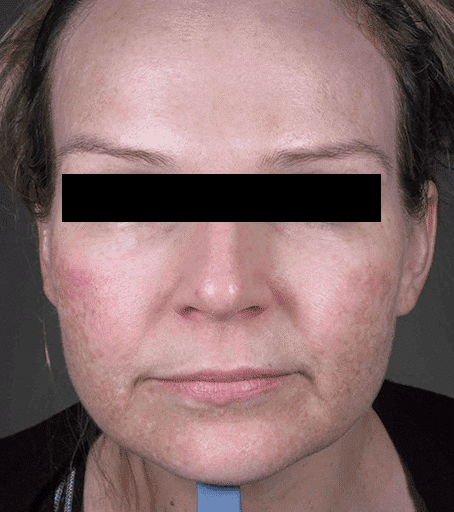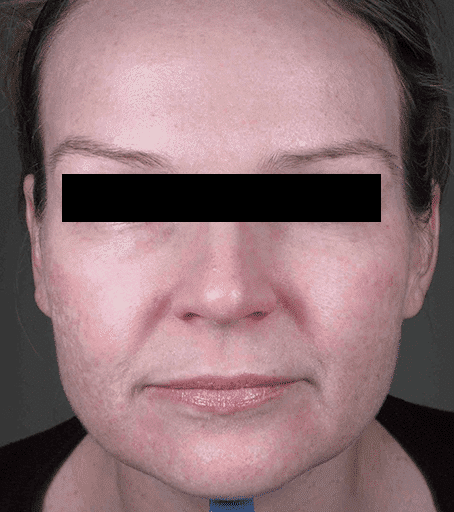
-Acne scars, regardless of their age or severity, can be improved through treatment.
-The type of treatment depends on three factors: skin type, scar type, and downtime.
- Our dermatologists utilise various techniques, including subcision, deep peels, surgery, lasers, and other energy devices, to improve acne scars.
- Each type of scar requires an optimal treatment approach.- Matching scar types and skin types to specific treatment procedures is essential for achieving success.
- On average, 70-80% of acne scars can be improved with bespoke revision.










Our dermatologists take a comprehensive approach to scar revision by carefully considering the depth and type of scars on a patient's skin. We conduct a thorough examination of the skin and palpate the skin to identify any issues related to laxity and turgor. In some cases, we may ask patients to animate their facial expressions to locate any tethers and attachments.
Based on this detailed examination, we formulate a customised treatment plan that takes into account each patient's unique needs and circumstances. We understand that no two patients are alike, and therefore, no two treatments should be the same. This personalized and meticulous approach sets us apart from other clinics and enables us to achieve optimal results for our patients.

Our experienced dermatologists and nurses specialise in scar revision by matching treatments to the type of scars. The available treatments include:
We carefully select the appropriate treatment based on the type of scar and the patient's individual needs to ensure the best possible outcome.

Our acne scar treatments typically result in a global improvement of 70% for most patients who undergo our scar management program. For patients with predominantly ice-pick and boxcar scars, the improvement can be as high as 95%.
It is important to note that when we refer to 'global improvement,' we are speaking of the overall improvement of the majority of scars, rather than just a single scar visible in a mirror held at a certain angle and distance from the face.

Our approach to scar revision is centered on finding the optimal treatment for each individual scar. Rather than relying solely on laser treatments or energy devices, we utilize a variety of non-laser methods, carefully selecting the appropriate treatment based on the scar type.
As most patients typically have mixed scars, such as rolling scars, box scars, ice-pick scars, and anchored scars, we use a combination of modalities, including surgery, peels, and in some cases, lasers.
We understand that each type of acne scar requires a specific treatment approach, and our technique ensures that we match the appropriate treatment to the specific scar type, resulting in optimal outcomes for our patients.

At Scars and Lasers, we recognise that understanding the different types of scars is essential for effective treatment. The following are the most common types of acne scars, categorised based on their depth:
Matching the appropriate treatment to the level of scarring is the next step in achieving optimal outcomes. Scar typing can be a complex process, and our expert nurses and dermatologists are available to provide guidance and support. Book an appointment with us to learn more about the different types of acne scars and how we can help you achieve your desired results.

Proper identification of scar types is crucial in determining the most effective treatment. Matching the correct treatment with the specific scar type can lead to a more predictable outcome (assuming proper execution of the procedure). Here are some treatments that can be used for various scar types:

We use dermal fillers to treat acne scars when the body is unable to generate enough collagen to repair atrophic scars, which can be due to factors such as genetics, age, health (such as smoking), or diet. If atrophic areas persist despite attempts to improve them, dermal fillers can be considered.
We use both HA fillers and collagen-stimulating dermal fillers, with the latter being preferred.

Scar revision in patients with darker skin tones is more complex due to two main reasons. Firstly, post-inflammatory hyperpigmentation (PIH) or skin darkening can occur with peels and lasers, while loss of pigment is rare. Secondly, hypertrophic and keloid scars are more common in darker skin.
To address these concerns, our dermatologists use special lasers, energy devices, and peel concentrations tailored to the patient's skin type. In many cases, we prescribe pigment correctors post-treatment. Darker skin patients generally require 2-3 more treatment sessions compared to those with lighter skin.

At Scars and Lasers, we use lasers or energy devices based on the scar type, skin type, and the patient's desired downtime. The devices we use include:
In many cases, we may employ two or more devices if necessary to achieve optimal results.
When it comes to treating acne scars with lasers, CO2 lasers such as our Alma Hybrid are generally considered the most effective. For severe scarring, hybrid lasers are often used. For more information on using CO2 lasers to treat acne scars, please refer to the provided link to the CO2 laser section.

At our practice, we use TCA CROSS (TriChloroAcetic Acid Chemical Reconstitution of Skin Scars) to treat deep acne scars such as ice-pick scars, boxcar scars, and enlarged skin pores. This technique has been in use for over a decade and is still considered one of the best methods for treating these types of scars. Most patients will require 2-4 treatments for optimal results.
We apply TCA using various delivery methods such as a toothpick, syringe or brush.

At Scars and Lasers, we use RF (radiofrequency) microneedling to stimulate scar remodeling. Unlike traditional microneedling, the device emits pulse energy at the tip, which is transferred as heat. This heat stimulates the production of heat shock proteins (HSP), which are responsible for the marked scar remodeling seen with RF treatments.
RF microneedling is an effective adjunctive treatment for rolling scars and can also improve boxcar scars and shallow ice picks. For more information on RF microneedling and its application in treating acne scars, please refer to the provided link to the Secret RF section on our website.

Our dermatologists use subcision as a surgical procedure to treat deep tethered acne scars. This procedure is essentially keyhole surgery for the face and may be done under sedation.
Subcision involves breaking up scar tissue from underneath, making it most useful for atrophic rolling scars. It can also be used to treat icepick scars (the scars beneath the picks) as well as polymorphic acne scars. Scar revision specialists now perform cannula subcision as it is considered to be infinitely better than hypodermic needle 'point' subcision.
In most cases, we perform subcision along with other procedures such as TCA CROSS or laser resurfacing for optimal results.

We can predict outcomes in 85-90% of cases based on the patient's scar pattern. Scars and Lasers will provide realistic timelines, costs, and expected outcomes.
However, there are three caveats to consider.
Firstly, inflammation matters as background acne can compromise the scar revision process. Scar revision involves building collagen, and if there is even a small amount of inflammation, the potential for regeneration is limited. Our dermatologists will address any active acne during the revision process.
Secondly, immune response varies between individuals, with some being more efficient at building collagen than others.
Finally, age matters as older patients are generally less efficient at building collagen, and support for the overlying scars may be diminished. Despite these factors, we work to achieve the best possible outcomes for our patients.

We understand that undergoing scar revision is an investment of time, effort, and money for patients. To help you along your journey, here are some helpful points to consider.
Firstly, it is essential to always control your acne before undergoing scar revision treatment. Absolute or almost absolute control is necessary, as inflammation can compromise collagen remodeling. If in doubt, seek professional advice from our dermatologists and nurses.
Secondly, collagen remodeling does not occur in weeks but months, so it is crucial to be committed to the timeline and treatment plan.
Sun protection is paramount, and we recommend using SPF 50+ twice a day regardless of exposure. For patients with darker skin types, more treatment sessions may be required, and we will work with you to lighten any expected darkening of the skin.
Cost is also a factor to consider, and Scars and Lasers can provide cost-effective treatment options to help you budget your spend and maximise your gains.
Lastly, the settings of lasers and devices matter, with parameters being crucial for the best outcomes. We use the best brands and employ the latest technologies to ensure optimal treatment results.

Scar revision procedures carry a small risk of adverse events that should be differentiated from expected outcomes and healing times. These include infection, which occurs in about 1-3% of cases and is easily managed. Prolonged pigmentation changes are more common in darker skin ethnicities, and idiosyncratic scars are very rare, occurring in less than 2% of cases but are treatable. Bleeding and hematomas occur in 2-5% of cases, depending on the instruments and procedures used.
Your treating specialist will discuss specific risks based on the procedure, and steps will be taken to minimize these risks and optimise your overall treatment outcome.
For all appointment enquiries, medical referrals and urgent enquiries please contact us at info@scarsandlasers.co.nz or (09) 524 5011.
